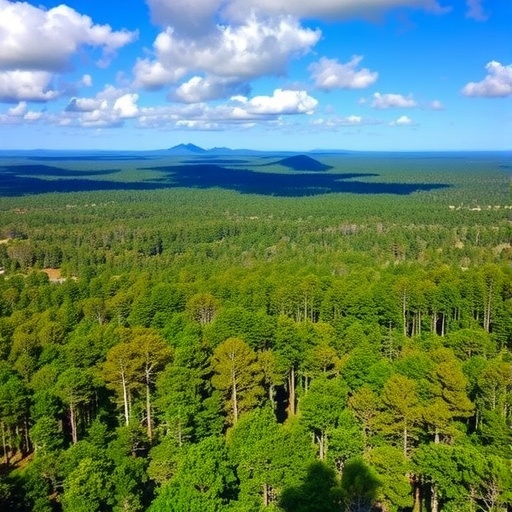Australia’s Tropical Rainforests Shift from Carbon Sinks to Carbon Sources Amid Climate Crisis
In a startling revelation from a recent study published in Nature, Australia’s tropical rainforests—renowned for their lush biodiversity and critical role in carbon sequestration—are now emitting more carbon dioxide than they absorb. This alarming transformation in the forests’ carbon balance is primarily driven by a combination of increased temperatures, atmospheric dryness, and prolonged drought conditions attributable to anthropogenic climate change. The findings signify a paradigm shift in the ecological functionality of these vital ecosystems and foreshadow profound implications for global climate mitigation efforts.
Woody biomass, which comprises trunks, branches, and living woody tissue in trees, has historically acted as a robust carbon sink. Typically, tropical forests absorb vast quantities of carbon dioxide from the atmosphere, locking it into this biomass and aiding in the regulation of the global carbon cycle. However, the new research reveals that the net flux of carbon associated with Australia’s tropical woody biomass has inverted, representing a net source of emissions. This change is unprecedented on a global scale, positioning the Australian wet tropics as the first tropical forest region to demonstrate this worrisome trend.
Dr. Hannah Carle, the study’s lead author from Western Sydney University, highlights that this deviation is predominantly a consequence of climate-induced stress leading to increased tree mortality. Elevated temperatures aggravate evapotranspiration rates, intensifying atmospheric dryness and imposing drought stress on forest ecosystems. These conditions weaken tree resilience, making them more susceptible to fatal damage. Consequently, while carbon release through decomposition and respiration accelerates, the compensatory growth that would normally replenish biomass is failing to materialize, undermining the forests’ capacity to absorb atmospheric CO2.
The research underscores an essential contradiction in the carbon dynamics of these ecosystems. Elevated CO2 concentrations are generally expected to stimulate photosynthesis and biomass accumulation—a phenomenon known as the CO2 fertilization effect. Yet, despite rising CO2 levels, tree growth rates have not increased sufficiently to offset mortality-related carbon losses. This counterintuitive result suggests that other environmental factors, such as water availability and heat stress, are exerting overriding control on forest productivity and carbon sequestration potential.
The shift from sink to source challenges the reliability of current climate models and carbon accounting frameworks that include tropical forests as major carbon sinks. Many emission reduction policies and international agreements, such as the Paris Agreement, count on the continued carbon uptake capacity of tropical forests to meet global targets. If these ecosystems are vulnerable to becoming carbon emitters, it compels a critical reassessment of mitigation strategies and highlights the urgency of addressing climate change at its root.
Moreover, the study identifies tropical cyclones as additional disturbances that further suppress the carbon sink function of woody biomass. Cyclone activity is projected to intensify in frequency and severity due to climate change, potentially exacerbating biomass loss and reducing forest resilience. Importantly, the expansion of cyclone impact areas could threaten forest regions previously unaffected, amplifying the scale of carbon emissions from tropical rainforests and compounding global climate feedback loops.
Professor Adrienne Nicotra from The Australian National University emphasizes the importance of the long-term, high-resolution datasets underpinning the study. Such continuous ecological monitoring is critical for detecting early warning signals of ecosystem upheaval and understanding the nuanced interactions between climate stressors and forest health. This comprehensive data reveals not just snapshots but trends that call for urgent conservation attention.
The implications of the study extend beyond the boundaries of Australian forests, as tropical rainforests globally face analogous pressures from climate change. The potential for widespread biome shifts—from carbon sinks to sources—represents a tipping point in Earth’s climate system, with profound consequences for atmospheric CO2 concentrations and climate feedback mechanisms. Scientists warn that without mitigating climate change drivers, more tropical forests could follow this trajectory, diminishing one of the planet’s most vital carbon buffering systems.
Beyond carbon flux, changes in forest structure and composition stemming from climate-induced mortality threaten biodiversity loss and ecosystem service disruption. The degradation of these forests compromises habitat for numerous endemic species and alters hydrological cycles critical to both local communities and downstream environments. Such cascading effects underscore the multifaceted risks inherent in forest carbon dynamics.
In conclusion, this groundbreaking study sets a precedent in tropical forest ecology and climate science, demonstrating the fragility and vulnerability of ecosystems once assumed to be robust carbon sinks. It signals an urgent need for enhanced global efforts to curtail greenhouse gas emissions, alongside adaptive strategies to bolster forest resilience. As tropical rainforests transition from allies in climate mitigation to sources of carbon emissions, the path forward demands integrated approaches combining climate action, forest conservation, and ecosystem management to sustain planetary health.
Subject of Research: Climate change impact on carbon balance of Australian tropical rainforest woody biomass
Article Title: Aboveground biomass in Australian tropical forests now a net carbon source
News Publication Date: 15-Oct-2025
Web References: https://doi.org/10.1038/s41586-025-09497-8
Image Credits: Adrienne Nicotra/ANU
Keywords: Environmental management, Tropical forest carbon dynamics, Climate change impacts, Carbon sink vulnerability




